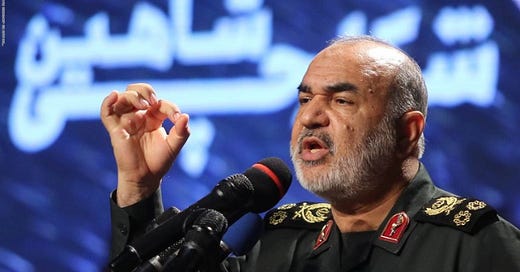Attack on Iran: Who Were the Iranian Commanders and Scientists Killed by Israel?
By Palestine Chronicle Staff
Iran confirms the deaths of senior IRGC commanders and nuclear scientists in Israeli airstrikes—here’s who they were.
Iranian Supreme Leader Ali Khamenei and official state media have confirmed the deaths of several senior military commanders and nuclear scientists following Israeli airstrikes on multiple locations across Iran at dawn on Friday.
Khamenei emphasized that “their successors and colleagues will immediately resume their duties,” signaling Iran’s intent to maintain operational continuity despite the losses.
According to the US-based outlet Axios, an Israeli official stated that the strikes deliberately targeted top Iranian military leaders and nuclear scientists.
These are the most prominent figures Tehran has announced were killed in the attack:
Hossein Salami
Born in 1960 near Golpayegan in Isfahan Province, Hossein Salami was a prominent Iranian military figure and commander of the Islamic Revolutionary Guard Corps (IRGC).
He studied mechanical engineering in Tehran before joining the IRGC following the outbreak of the Iran-Iraq War (1980–1988), where he held command over several air and naval divisions on the western and southern fronts.
In 1992, Salami founded the IRGC’s Command and Staff University in Tehran, known as the “Davos Course,” aimed at training specialized military personnel.
He led the institution until 1996 before assuming the role of Deputy Chief of Operations of the IRGC Joint Staff, a position he held until 2005.
In that same year, Salami was appointed commander of the IRGC Air Force, serving until 2009. He was then named deputy commander-in-chief of the IRGC, a role he maintained for a decade until 2019.
In addition to his field responsibilities, he also taught at the National Defense University and briefly served as acting assistant director of IRGC coordination in 2018.
In April 2019, Supreme Leader Khamenei promoted Salami to the rank of major general and appointed him commander-in-chief of the Revolutionary Guards, making him the eighth official to lead the military body that operates parallel to Iran’s national army. That same year, the US imposed sanctions on him and other senior IRGC commanders.
Mohammad Hossein Bagheri
Also known as Mohammad Hossein Afshordi, Bagheri was born in 1958 and became one of Iran’s most senior military commanders. A veteran of the Iran-Iraq War, he was the younger brother of Hassan Bagheri, a founding figure of the IRGC’s intelligence and operations division.
Bagheri joined the IRGC in 1980, abandoning his mechanical engineering studies due to the Cultural Revolution and university closures. He later earned a PhD in political geography from Tarbiat Modares University and taught at the National Defense University.
His career included key roles in field operations, intelligence, and military planning. He served during the Kurdish insurgency in the country’s northwest in the early 1980s and played a leading role in IRGC operations against Kurdish opposition groups throughout the 1990s. Bagheri also held intelligence roles in the Karbala and Khatam al-Anbia headquarters—the latter being the engineering arm of the IRGC.
In 2008, he was promoted to major general. Between 2002 and 2014, he served as Deputy Chief of the Intelligence and Operations Division of the Armed Forces General Staff. On June 28, 2016, Khamenei appointed him Chief of Staff of Iran’s Armed Forces, succeeding Major General Hassan Firouzabadi.
Fereydoun Abbasi Dawai
Born on September 8, 1958, in Abadan, Fereydoun Abbasi Dawai was a nuclear physicist, senior IRGC officer, and university professor. He earned his PhD in nuclear physics from Shahid Beheshti University and joined the IRGC in 1978.
Abbasi played a key role in Iran’s uranium enrichment efforts and served as head of the Atomic Energy Organization of Iran (AEOI) from 2010 to 2014. He was also appointed Vice President under President Mahmoud Ahmadinejad and later elected to parliament in 2019, representing the Kazerun and Kohjnar constituency.
He was affiliated with several leading academic institutions, including Shiraz University, Ferdowsi University of Mashhad, and Amir Kabir University of Technology, and served as head of the Physics Department at Imam Hussein University.
A target of multiple Israeli assassination attempts, Abbasi was injured along with his wife in a 2010 car bombing that also killed fellow scientist Majid Shahriari. Prior to his death, he was considered one of Iran’s most influential nuclear experts.
Gholam Ali Rashid
Major General Gholam Ali Rashid, commander of the Khatam al-Anbia Central Headquarters of the IRGC, was also confirmed killed.
Rashid was a key strategist responsible for overseeing coordination among Iran’s military branches and planning high-level defense operations.
Iranian media also reported the deaths of:
Ahmed Reda Zolfaghari, a professor of nuclear engineering.
Mehdi Tehranchi, a nuclear scientist and president of Islamic Azad University.
Unconfirmed reports suggest that Ali Shamkhani, a senior advisor to Supreme Leader Khamenei and former Secretary of the Supreme National Security Council, was critically injured in the Israeli strikes and has been hospitalized in serious condition.
These strikes represent a major escalation in the shadow war between Israel and Iran, targeting the very core of Iran’s military and scientific leadership.
(PC, AJA)





